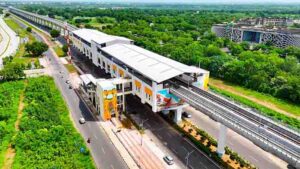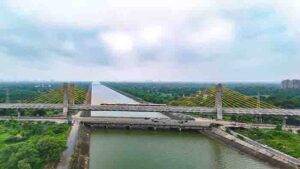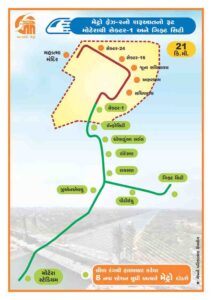GANDHINAGAR, SEPT 11
Ahead of his 75th birthday, Prime Minister Narendra Modi will flag off the second phase of the Metro on Monday, marking the official commencement of operations. This new phase, stretching from Motera to Gandhinagar’s Sector-1, will connect crucial hubs such as GIFT City, infusing new dynamism into the regional economy by facilitating easy access for professionals, students, and tourists. This phase spans up to 21 kilometres, covering a total of eight new stations initially, providing seamless and efficient transportation services to both residential and commercial areas.


- This will connect Narendra Modi Stadium to Gandhinagar’s Sector-1 and GIFT City
- New operational route is 21 km Extension of Existing North -South corridor of Ahmedabad metro phase-I with initial eight operating stations.
- Metro Journey from APMC to Gandhinagar’s Sector-1: 33 km in 65 minutes for ₹35, far outpacing taxi costs
- Metro Rail Extension to seamlessly connect Ahmedabad and Gandhinagar twin cities
- Metro to be the most economical and reliable public transport with affordable fares and predictable travel time at most comfort level
- The service will greatly help in easing traffic on Ahmedabad’s busy roads, reducing both pollution and the strain on existing transport infrastructure
With this, Gujarat is set to witness a monumental leap in its public transportation infrastructure with the launch of the much-awaited Metro Rail Extension. This ambitious project, developed by the Gujarat Metro Rail Corporation (GMRC) in collaboration with the Government of Gujarat and the Government of India, will further expand the metro network, linking key locations between Ahmedabad and Gandhinagar like GNLU, PDEU, Gift City, Raysan, Randesan, Dholakuva, Infocity and Sector-1. The extension promises not only to boost connectivity between the two cities but also to redefine urban mobility in the region with faster, safer, and more affordable travel options for citizens.

A major step towards affordable and efficient urban transport
One of the defining features of the Metro Rail Extension is its affordability and time efficiency. With the continuous rise in fuel prices and increased traffic congestion, the Metro stands out as the most economical and reliable form of public transport available.
For instance, the Metro journey from APMC to Gandhinagar’s Sector-1, which spans approximately 33 km, takes just 65 minutes and costs ₹35. In comparison, the same journey via taxi can take over 80 minutes, with fares exceeding ₹415. Similarly, autorickshaw fares for this route hover around ₹375, taking the same amount of time or longer. By offering affordable fares and predictable travel times, the Metro is poised to become the go-to choice for daily commuters, students, and professionals working in the rapidly developing areas of Gandhinagar and GIFT City.
Sustainable urban mobility to reduce the carbon footprint
Further, the Metro’s clean energy and efficient design significantly reduce the carbon footprint, making it a more sustainable option compared to private vehicles. The service will greatly help in easing traffic on Ahmedabad’s busy roads, reducing both pollution and the strain on existing transport infrastructure.
The Metro Rail Extension will open up vital connections between Ahmedabad and Gandhinagar, serving an anticipated large volume of passengers every day. Some key details of the project include:
Route and distance
The second phase of the Metro covers a distance of 21 km, stretching from Motera to Gandhinagar’s Sector-1.
Key stations include GNLU, PDEU, Gift City, Raysan, Randesan, Dholakuva Circle, Infocity, and Sector 1, all strategically located to provide maximum convenience to passengers.
The total project cost for Phase II stands at ₹5,384 crore
The total project cost for Phase II stands at ₹5,384 crore, with funding secured through loans from international agencies AFD and KfW. This financial backing underscore the government’s commitment to delivering high-quality infrastructure and fostering regional economic growth.
Reduced travel time
The extended route dramatically reduces the travel time between Ahmedabad and Gandhinagar. For instance, commuters can now travel between APMC and GIFT City in under an hour, at a cost of around ₹35.
Environmental benefits
The Metro’s operation helps lower vehicular emissions, offering a greener alternative to private cars, taxis, and two-wheelers. As cities across India continue to battle air pollution and traffic congestion, the Metro Rail Extension represents a forward-thinking solution that supports both the environment and economic development.
Economic and social impact
The Metro’s new stations will bring major social and economic benefits to the region, particularly with the expansion of commercial centres around GIFT City and Infocity. Professionals working in these areas will now have a fast and affordable commute option, which will increase productivity and support the growth of businesses in the region.
The Metro Rail Extension is expected to boost real estate development around the new stations. As connectivity improves, the demand for housing and commercial spaces in the surrounding areas will rise, creating opportunities for new investments and driving urban growth. By connecting key urban areas and providing an affordable means of transport, the Metro will also play a significant role in improving the quality of life for residents. The savings in time and money for commuters, as well as the reduced reliance on personal vehicles, will have long-lasting effects on the health, well-being, and financial security of the population.
Future-proofing Gujarat’s urban infrastructure
Looking ahead, this Metro expansion is just one part of Gujarat’s broader strategy to build a robust and sustainable urban transport network. Plans for further extensions and enhancements to the Metro network are already underway, to create a fully integrated transport system that will serve the region for decades to come.
The Ahmedabad Metro Rail Extension represents a significant milestone in Gujarat’s path to becoming a global urban centre. By improving connectivity between Ahmedabad and Gandhinagar, it provides a more sustainable, affordable, and convenient travel option for all.












